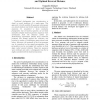Free Online Productivity Tools
i2Speak
i2Symbol
i2OCR
iTex2Img
iWeb2Print
iWeb2Shot
i2Type
iPdf2Split
iPdf2Merge
i2Bopomofo
i2Arabic
i2Style
i2Image
i2PDF
iLatex2Rtf
Sci2ools
CSB
2005
IEEE
2005
IEEE
Bacterial Whole Genome Phylogeny Using Proteome Comparison and Optimal Reversal Distance
Traditional phylogenetic tree reconstruction is based on point mutations of a single gene. This approach is hardly suitable for genomes whose genes are almost identical and hardly captures evolutionary scenarios. To reconstruct a more conclusive phylogenetic tree of bacterial genome, all currently available complete bacterial genomic sequences were downloaded from the National Center for Biotechnology Information (NCBI). Each individual proteome was blasted against the collection and provided a number of homologous genes shared with others. Moreover, the syntenies of each two genomes can be considered as two signed permutations. One permutation can be rearranged into another in finite steps, called reversal distance. These two measures were combined and yield a phylogenetic tree that is highly consistent with the bacterial taxonomy.
Bioinformatics | Conclusive Phylogenetic Tree | CSB 2005 | Phylogenetic Tree | Phylogenetic Tree Reconstruction |
| Added | 24 Jun 2010 |
| Updated | 24 Jun 2010 |
| Type | Conference |
| Year | 2005 |
| Where | CSB |
| Authors | Noppadon Khiripet |
Comments (0)

